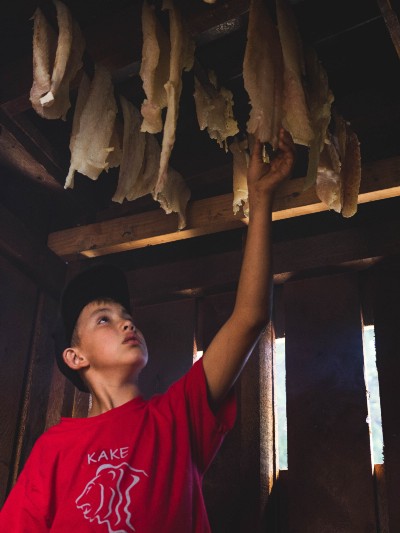I arrived in Kake, Alaska (Ḵéex̱ʼ Ḵwáan) on one of my earlier projects as an intern with collaborator and videographer, Kendall Rock. We were traveling all over Southeast Alaska to gather stories of the inherent relationship between Southeast Alaskans, wildly harvested seafoods, and the pristine water that makes it all possible. When we joined Kake’s annual culture camp it became immediately apparent how real it was. Real in the sense that these youngsters, in a small Tlingít community, were learning and applying skills that would profoundly influence the rest of their lives.
We entered to a scene of two freshly killed seals being shuttled from a boat to the shore. A bright red pool of blood settled in the bottom of the gritty, yet vibrant blue wheelbarrow as the seals were hoisted out, gutted, and sent up the beach to be further processed. The pelts were saved and the meat was canned. The elders demonstrated how the lungs could be expanded and used as a buoy. The intestines were braided and sent to the smokehouse. Nothing was wasted.
As the camp went on, lessons were learned as older generations shared important contexts, “Celebrate this animal. It has died so it can feed you and your family." Each animal, a new offering from the land and a reminder from the elders, "Do not disrespect it, our village would not live had these animals not provided for us." With humble admiration and respect, the youngsters sorted out the balance of learning ancestral ways of life as well as remaining young at heart.
In bouts of downtime, Chad, a middle-schooler, could be found soliciting wheelbarrow rides. I found Marty carrying a tall walking stick and sporting a trash-bag cape on his way to fill the bag with skunk-cabbage leaves for the salmon ground-bake. Jesse chuckled as he held his slimy hands up as antlers and danced in the rain. Kylie’s nail polish glistened as she dove, again and again, into slicing and butchering the meats that found their way to the processing table. As each moment passed, it became clear to me as an outsider that this youthful energy and willingness to learn was the beating heart of the camp — why it existed, why it would continue to exist, and what inspired elders and adults to be there sharing their knowledge.
Harnessing the youthful energy was exactly the point, Kendall and I later learned, as we interviewed one of the camp’s founding adults, Mike Jackson. Mike shared that Kake’s Culture Camp had been held annually for the last twenty-seven years. It came from a very real need, he told us, “we were losing our young — boys mostly — to suicide, and nobody was talking about it.” He looked off to the ocean and went on, “we needed to talk about it… we needed to show the value of young lives and the effects that family and loved ones felt when they lost their young.” Mike went on about the importance of an inter-generational transfer of knowledge. That an elder bestowing knowledge and stories can open a young mind to a larger perspective and a sense of belonging to something greater; a reason to exist. “It has gotten better,” Mike continued, while also reassuring that they still have so much to work on as a community. He spoke of the value of young adults having a genuine connection to place, environment, and food source as immeasurably important when he thinks about keeping the waters intact, which have supplied generations upon generations with food and legacy. “Year thirty is going to be a big one,” Mike said laughing, “we’re really going to celebrate,” as if the energy surrounding the drum circle, salmon bake, and community potluck of twenty-seventh year were just the start.
Later by the campfire, I thought long about the importance of a child’s upbringing. This community had shown me just the care, depth, and teamwork that goes into it. It is the collective inter-generational experience. It is the stories. It is the serving of humble pie from the lessons taught by elders and the similar serving-size of pride when later dancing to the drums of those same elders. It is the bear that keeps its distance from camp by way of an unspoken agreement. It is the eagles plucking away at the used halibut carcasses washed down shore. “You are born in the water of your mother, and we send you back to ocean’s water when you pass.” Mike finished, “Without it, we are nothing. Where will our livelihood come from?”
Faces glowed around the campfire. In a day where the majority of young faces in our country are illuminated, instead, by the glow of cell phones, it struck me: experiences like Kake’s culture camp are integral. Not just on remote Alaska island, but everywhere. When I imagine the smart, compassionate, and brave leaders of tomorrow, I imagine childhoods where scraped knees and dirty hands are prerequisites to learning and personal growth. Where understanding of the systems of life and sources of food comes from tactile and visceral contact with exactly that — life, the outdoors, and the billions of natural systems that thrive daily within. When I sat down to share and enjoy the meals of Kake’s culture camp, everyone knew where their food came from, and at what hands the fish had been processed and prepared by. Their gratitude was abundant. It was all spoken and thanked in Tlingít: Gunalchéesh! It is that kind of simplicity and clarity that I, and hopefully dinner tables all across the country can strive for each day; because what better way to inspire respect for our world than through good food and a content stomach?








No comments.